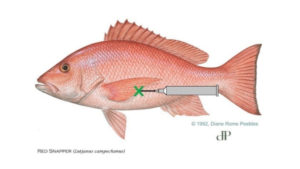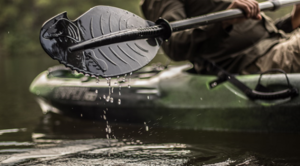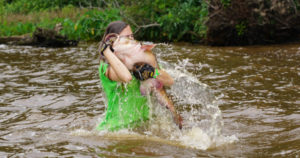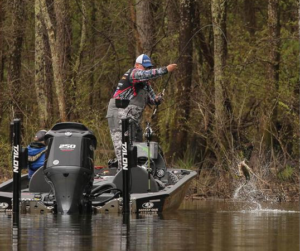September Bass at Eufaula
with Dwayne Smith
September is one of the worst months for bass fishing in many of our Georgia lakes. The water is at its hottest and bass are deep and hard to find. But at Lake Eufaula the numerous ledges are full of bass and the grassbeds all over the lake entice some bass to feed shallow. You can take advantage of both patterns and catch bass there this month.
With 45,180 acres of water, there are lots of places to fish at Eufaula. Stretching 85 miles from the dam to Columbus, this long lake is mostly river bottom with lots of shallow areas and good drops into channels. Those are perfect places for bass to hold and feed this month.
Eufaula is a shallow lake with big flats everywhere. Grass grows on many of these flats and points leading to the channels, and willow bushes grow all over the lake, even on some mid-lake ledges. Bass like to feed around this shallow cover and can be found there all year long, but this pattern gets even better in late September when the water begins go cool.
Dwayne Smith won the Georgia Bass Chapter Federation Top Six tournament at Eufaula last April. He won it early, catching a limit of bass on spinnerbaits first thing each morning. Fishing with the Blackshear Bass Club for the past six years has taught Dwayne a lot about the lake since they fish it about four times a year, and he put his knowledge to good use in the Top Six.
Making the Top Six team each year that he has been in the club is something Dwayne is proud of doing, and he likes fishing the Top Six. He also likes Eufaula and can catch fish there most of the year. He says September can be a good month if you know were to fish.
“Start early in the grassbeds, then move to the drops as the sun gets on the water,” Dwayne said. That is a simple pattern but it works well for him most of the year, and September is no exception.
Dwayne will start each morning throwing a half-ounce white Terminator spinnerbait with a gold willowleaf and a silver Colorado blade. He likes a split tail white trailer and says the bait looks so good in the water sometimes he wants to eat it himself! The spinnerbait is fished in the shallows all over the lake, anywhere there is grass or willows.
Dwayne may start out on the main lake on humps but the sun hits those areas early. As the sun comes over the trees he will often move to the shady bank to get some more time with his spinnerbait. But when the sun gets bright, it is time to move to deeper water.
“Look for shallow water near deep water,” Dwayne said. A drop from the shallows to the channel is going to hold bass, and the steeper the drop the better it usually will be. Dwayne will fish a Carolina rig on these places, casting up shallow and working his bait down to deeper water.
A black Trick worm rigged behind a one ounce sinker on a 24 to 30 inch leader is Dwayne’s standard Carolina rig. He likes heavy line on both spinnerbait and Carolina rig, and uses 15 pound Trilene Big Game line on everything, including his leader.
You will often see bass busting shad on top during September, so Dwayne also keeps a chrome half-ounce Rat-L-Trap rigged and ready to cast toward them. And he will have a big Fat Free Shad on another rod to run across shallow drops in case the bass want something moving a little faster than a Carolina rig. He likes shad colored crankbaits if the water is clear and something with some chartruese in it if the water is stained.
I fished with Dwayne in early August to get a look at the way he fishes Eufaula. He showed me ten of his favorite places to fish in September to share here, and he explained how he fishes each. The following ten spots will give you some grassbeds and shallows to fish this month as well as drops to move to when the sun gets bright.
1. N 32 03.171 – W 85 03.321 – The bank straight across from the mouth of Little Barbour Creek has a good grassbed and is on the east side of the lake, so it stays shady for a good while each morning. Dwayne will start right across from the mouth of the creek and fish upstream all the way to the small creek.
Keep your boat out and easy cast from the bank and throw your spinnerbait back into the edge of the grass. Fish it back out, running it by any clumps of grass or any wood cover out from the bank. Dwayne fishes the spinnerbait fast, keeping is down under the water but running it back quickly at a steady speed. Making a lot of cast as fast as possible is important since this pattern does not last long.
2. N 32 01.997 – W 85 03.413 – Head downstream and the channel will make a sharp bend to the Georgia bank, then swing out toward the Alabama side. Right where the channel leaves the east bank there is a small island. A point runs off this island and follows the edge of the channel as it cuts across the lake. There is a red channel marker just off the island.
Dwayne likes to keep his boat upstream of the drop running off the island and casts up onto the flat formed by the point. He will work his Carolina rig or crankbait back to the boat, fishing some of the top of the flat and then covering the edge of the drop.
If there is current moving the lip of the drop is probalby the best spot. If the current is not moving Dwayne will work the Carolina rig down the drop and probe for any wood stuck there. He will work from the island out to the channel marker, fishing the edge all along there.
3. N 32 01.546 – W 85 02.876 – Head on downstream and the channel goes to the Alabama bank then makes a sharp turn back to the Georgia side. The mouth of Rood Creek is where the channel hits the Georgia bank, but just upstream is a small creek with a split near the mouth. The river channel runs near the mouth of it and the double opening has deep water in it.
The point on the split in the mouth of this creek has a hump off it that has stumps on it. It is only four feet deep on top and drops off to 25 feet or deeper all around. Keep your boat out in the deeper water and fish around the hump, making casts up on top of it and fishing down the slope.
This is a good place to run a crankbait across the top of the hump, then fish a Carolina rig on it. You will get hung up on the stumps but there will often be bass holding by them, too. Fish this spot carefully, taking time to cover it from all angles.
4. N 32 00.670 – W 85 03.605 – Downstream of Rood Creek the channel swings toward the Alabama bank and then right back to the Georgia side. A little further downstream it angles across the lake to the Alabama side, and just upstream of where it hits the bank is an opening to a big flat split by an island. This big area is actually the ends of two old oxbow river runs cut off from the lake by an island. Dwayne calls the big flat grassy area behind the island “The Barn.”
This very shallow water has lilly pads and other grass along the bank. Out in the middle you will see clumps of hydrilla. Bass will feed here year round, but move in more as the water starts to cool near the end of September.
Start fishing near the mouth and cast to every cut and hole in the grass and pads. Watch for dark clumps out in the middle of the open water and fish them with your spinnerbait, too. Run your spinnerbait along and through every fishy looking spot.
5. N 31 59.003 – W 85 04.129 – Head downstream past the mouth of the Witch’s Ditch and the lake will open up. The island that runs parallel to the river on the Georgia side, the one that cuts off the Witch’s Ditch, ends and the lake will open up. Just downstream of the end of this island is a red channel marker and there is a good river ledge here where the channel makes a small turn toward the Alabama bank.
Position your boat just downstream of the marker and you will be in about 40 feet of water. You can cast up onto the top of the ledge to 12 feet of water and fish the stumps on it. Fish all long this ledge, trying a crankbait and then the Carolina rig. When you hit a stump, pause your bait and let the bass have a good look at it. If you don’t get bit, cast right back to the same place to fish that stump again.
6. N 31 58.304 – W 85 03.888 – As you go downstream the channel will swing all the way to the Georgia side just below the mouth of Bustahatchee Creek. The red channel marker 103.1 will be near the bank and just upstream of it you will see some small willows sticking up out of the water about 200 feet off the mouth of a small creek called “The Watermelon Hole.” There is a big irrigation pump in this small creek and you can usually hear it running.
This hump was the site of a house before the lake was backed up, and the old brick foundation is still there. Fish all around this hump and the willows with your spinnerbait then back off a little and fish it with your Carolina rig. The river channel is just off the outside of it and the creek channel runs by it, too. Fish the drops into each with your Carolina rig and feel for the bricks. When you hit them fish them slowly.
Watch for schooling fish here. While we were fishing it some big shad scooted out of the water and Dwayne threw his Rat-L-Trap to it. He hooked a stong fish that fought more like a bass than a hybrid, and I was ready with the net when it got close to the boat. Unfortunately, the bass made a strong run and pulled loose before we saw it.
7. N 31 58.221 – W 85 03.924 – Just downstream of this hump, right at channel marker 103.1, the channel makes a sharp bend back toward Alabama and the mouth of Cowikee Creek. The water in the channel is 58 feet deep and it comes up to a shallow flat with a small point running out on it. You can see the small point as a buldge on the bank in the grassline.
Keep your boat out in the channel and cast up onto the flat. Some wood cover sticks here at times but the main feature is the drop. Fish the lip of the drop with crankbait and Carolina rig.
Dwayne told me this was a good spot hole as we pulled up on it, and he caught a small keeper spot here on his Carolina rig. Fish all long the lip of this drop as the channel swings away from the bank.
8. N 31 58.103 – W 85 05.776 – Run into the mouth of Cowikee Creek and head upstream until you get to the island on your right just outside the channel. The channel will make a wide sweeping bend all the way across the creek from the far bank to the end of this island and then back to the far bank. Stop just outside of the red pole channel marker that has a small number 271 on it that is standing off the end of the island. Keep your boat in the channel.
The outside bend here has brushpiles and stumps all along it. Dwayne will fish from this pole all along the outside bend all the way to the next red pole marker downstream. Near the channel marker at the end of the island Dwayne hung a strong fish on his Carolina rig but it got him down in the brush. He sawed it back and forth for a short time before it broke off.
9. N 31 54.845 – W 85 07.082 – Dwayne runs the Alabama side from the mouth of Cowikee Creek all the way to Old Town Creek Park. This is very shallow water and is dangerous if the lake is down any at all, which it may be in September. You are much safer following the channel.
When you get to Old Town Creek Park swimming area, just downstream of the fishing pier, a ledge runs way out from the swimming area toward the Georgia bank. It is called the “Closeline” because it runs so straight and far. Dwayne will keep his boat on the upstream side of this drop and fish all along it, casting up onto the top of the flat and working his Carolina rig down the drop.
There is some brush on this drop and the drop runs about even with the bank at the swimming area. If you look at the bank you can tell how it continues on out in the lake. If there is any current this is an excellent place and you can fish it out 100 yards or more. Current helps here just like on all other holes where there is a drop.
10. N 31 53.025 – W 85 07.843 – The last hole Dwayne showed me is a long point with rocks on it running out from the Alabama side. It is easy to find because there is a railroad on top of this point. The point he likes to fish is the railroad causeway on the Alabama side.
Dwayne will start on the upstream side of the causeway and work around the point with a crankbait or spinnerbait, casting up near the rocks and fishing back out. If there is current running around this point the bass will stack up on the rocks to feed on shad moving downstream. It is a good place all day long and is easy to find.
Give these spots a try and then use what you see on them to find others. There are acres of grassbeds on Eufaula and many of them hold bass. And the miles of river and creek ledges hold bass this time of year. Eufaula is one of our best lakes in September. Spend some time there.






